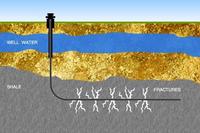-
Nuclear energy facilities proved themselves resilience during Hurricane Sandy

There are thirty-four nuclear energy facilities in the area hit by Hurricane Sandy; all of them have responded well and safely to the powerful storm; the industry says that careful planning and preparations days in advance of the storm paid off at all of these facilities
-
-
Hurricane Sandy offered support for reliance on nuclear power
A Scientific American writer is impressed with the way nuclear power facilities were able safely to withstand the wrath of Hurricane Sandy; the lesson he draws from this experience: “Global warming is increasing the probability and destructiveness of extreme weather events like Sandy. (I don’t see the point of dithering over this claim any more.) The last thing we should do in the face of this threat is abandon nuclear energy. If anything, we need more nuclear power, not less, to curb global warming”
-
-
Fracking: fact vs. fiction

In communities across the United States, people are hearing more and more about a controversial oil and gas extraction technique called hydraulic fracturing — aka, hydro-fracking; controversies pivot on some basic questions: Can hydro-fracking contaminate domestic wells? Does it cause earthquakes? How can we know? What can be done about these things if they are true? Experts making presentations at the Geological Society of America (GSA) meeting this week in Charlotte, North Carolina, will address these and related critical questions
-
-
USGS sampling water in Hurricane Sandy’s aftermath to ensure public health
Excessive nutrients in U.S. rivers, streams, and coastal areas are a major issue for water managers, because they cause algal blooms that increase costs to treat drinking water, limit recreational activities, and threaten valuable commercial and recreational fisheries; U.S. Geological Survey crews are sampling water for nutrients, sediment, and pesticides to document water quality in areas affected by the hurricane
-
-
Obama, Romney differ on major homeland security issues

Tomorrow, Tuesday 6 November, American voters will choose between Barack Obama and Mitt Romney as the next president of the United States; the state of the U.S. economy and the best ways to reduce unemployment and increase the pace of economic growth were at the center of the campaign, leaving little room for other issues. Homeland security issues, in particular, played little, if any, role in the campaign or in the three debates between the presidential candidates and the debate between the vice-presidential candidates; still, if we examine the policy proposals each candidate has made, and also examine the details of policies posted on his Web sites, the differences between the candidates’ approaches on three major homeland security issues – immigration, cybersecurity, and infrastructure – are considerable
-
-
States, localities to assume more responsibilities for rebuilding U.S. aging infrastructure
Infrastructure in the United States is in bad shape; Maryland needs more than $100 million a year for its bridges; Virginia needs $125 million per year for roads that need repaving; Washington’s failure to create a long-term funding plan to repair the nation’s infrastructure is forcing state and local governments to fill the void in federal funding
-
-
Biofuels from algae hold potential, but more work required to realize that potential
Scaling up the production of biofuels made from algae to meet at least 5 percent — about ten billion gallons — of U.S. transportation fuel needs would place unsustainable demands on energy, water, and nutrients, says a new report from the National Research Council (NRC); these concerns, however, are not a definitive barrier for future production, and innovations that would require research and development could help realize algal biofuels’ full potential
-
-
Sea levels are rising ahead of predictions; scientists explain why
The last official Intergovernmental Panel on Climate Change (IPCC) report in 2007 projected a global sea level rise between 0.2 and 0.5 meters by the year 2100; current sea-level rise measurements meet or exceed the high end of that range and suggest a rise of one meter or more by the end of the century; scientists meeting next week at the Geological Society of America annual meeting will discuss whether estimates of the rate of future sea-level rise are too low
-
-
Experts: German nuclear exit offers economic, environmental benefits
Following the accident at the Fukushima Daiichi Nuclear Power Station in 2011, the German government took the nation’s eight oldest reactors offline immediately and passed legislation which will close the last nuclear power plant by 2022; this nuclear phase-out had overwhelming political support in Germany; elsewhere, many saw it as “panic politics”; a new collection of studies shows that the nuclear shutdown and an accompanying move toward renewable energy are already yielding measurable economic and environmental benefits
-
-
U.K. govt. awards £37.1 million for civilian nuclear research
The U.K. Department for Business, Innovation and Skills has announced an award of 37.1 million pounds to the University of Sheffield’s Nuclear Advanced Manufacturing Research Center (Nuclear AMRC), which are working in partnership with Rolls-Royce as the lead company for the U.K. nuclear supply chain
-
-
Quick-cook method turns algae into oil
It looks like Mother Nature was wasting her time with a multimillion-year process to produce crude oil; University of Michigan engineering researchers can “pressure-cook” algae for as little as a minute and transform an unprecedented 65 percent of the green slime into biocrude
-
-
Rising sea levels make NYC vulnerable to more frequent, more intense floods
Scientists say that Hurricane Sandy has forced a recognition on New York City and on other coastal communities: the steady rise in sea levels means not only more floods, but more frequent and more devastating floods; three of the top 10 highest floods at the Battery since 1900 happened in the last two and a half years; after rising roughly an inch per decade in the last century, coastal waters in New York are expected to climb as fast as six inches per decade, or two feet by midcentury; the city is exploring a $10 billion system of surge barriers and huge sea gates
-
-
Study connects burning fossil fuels to sea level rise
A study has found that burning all the Earth’s reserves of fossil fuels could cause sea levels to rise by as much as five meters — with levels continuing to rise for typically 500 years after carbon dioxide emissions ceased
-
-
Calculating the benefits of switching from food to energy crops
Along with the growing interest in biomass energy crops as renewable alternatives to fossil fuels comes a growing list of questions from corn and soybean farmers about what it will cost them to switch; researchers developed a customizable online calculator to eliminate some of the guesswork and help farmers make the decision
-
-
Death, destruction in wake of Hurricane Sandy
Hurricane Sandy’s left millions along the U.S. East Coast without power or mass transit, in all likelihood for days; the U.S. death toll reached 48, with most of the dead being killed by falling trees; the hurricane cut power to more than 8.2 million across the East Coast; airlines canceled more than 15,000 flights; Sandy will end up causing about $20 billion in property damage and $10 billion to $30 billion more in lost business, making it one of the costliest natural disasters on record in the U.S. history
-
More headlines
The long view
Water Wars: A Historic Agreement Between Mexico and US Is Ramping Up Border Tension
By Natasha Lindstaedt
As climate change drives rising temperatures and changes in rainfall, Mexico and the US are in the middle of a conflict over water, putting an additional strain on their relationship. Partly due to constant droughts, Mexico has struggled to maintain its water deliveries for much of the last 25 years, deliveries to which it is obligated by a 1944 water-sharing agreement between the two countries.
Trump Is Fast-Tracking New Coal Mines — Even When They Don’t Make Economic Sense
By Katie Myers
In Appalachian Tennessee, mines shut down and couldn’t pay their debts. Now a new one is opening under the guise of an “energy emergency.”
Smaller Nuclear Reactors Spark Renewed Interest in a Once-Shunned Energy Source
By David Montgomery
In the past two years, half the states have taken action to promote nuclear power, from creating nuclear task forces to integrating nuclear into long-term energy plans.
Keeping the Lights on with Nuclear Waste: Radiochemistry Transforms Nuclear Waste into Strategic Materials
By John Domol
How UNLV radiochemistry is pioneering the future of energy in the Southwest by salvaging strategic materials from nuclear dumps –and making it safe.
Model Predicts Long-Term Effects of Nuclear Waste on Underground Disposal Systems
By Zach Winn
The simulations matched results from an underground lab experiment in Switzerland, suggesting modeling could be used to validate the safety of nuclear disposal sites.
